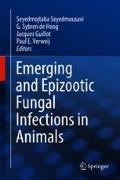Abstract
An infectious disease has caused high mortalities in the Brazilian mangrove-land crab, Ucides cordatus. The lethargic crab disease spread northward and southward in waves from Pernambuco State in Brazil. Primary causative agent was the black yeast Exophiala cancerae, with Fonsecaea brasiliensis as a secondary, opportunistic invader. The reasons for coming and going of the disease may be of intrinsic as well as of environmental nature.
Access this chapter
Tax calculation will be finalised at checkout
Purchases are for personal use only
References
Alves RRN, Nishida AK (2003) Socio-economical aspects, environmental perception of ‘Caranguejo-uçá’, U. cordatus (L.1763) (Decapoda, Brachyura) gatherers in the Mamanguape river estuary, northeast Brazil. Interciencia 28(1):36–43
Ávila RP, Mancera PFA, Esteva L et al (2012) Traveling waves in the lethargic crab disease. Appl Math Comput 218(19):9898–9910
Boeger WA, Pie MR (2006) Montando o quebra-cabeça. Revista do GIA 2:34–36
Boeger WA, Pie MR, Ostrensky A et al (2005) Lethargic crab disease: multidisciplinary evidence supports a mycotic etiology. Mem Inst Oswaldo Cruz 100(2):161–167
Boeger WA, Pie MR, Vicente VA et al (2007) Histopathology of the mangrove land crab Ucides cordatus (Ocypodidae) affected by lethargic crab disease. Dis Aquat Org 78:73–81
de Hoog GS, Guarro J, Figueras MJ et al (2009) Atlas of clinical fungi, 3rd CD-ROM edn. CBS-KNAW Fungal Biodiversity Centre. Universitat Rovira i Virgili Reus, Utrecht
de Hoog GS, Vicente VA, Najafzadeh MJ et al (2011) Waterborne Exophiala species causing disease in cold-blooded animals. Persoonia 27:46–72
Dover CLV, Ward ME, Scott JL et al (2007) A fungal epizootic in mussels at a deep-sea hydrothermal vent. Mar Ecol 28:54–62
Ferreira CP, Pie MR, Esteva L et al (2009) Modelling the lethargic crab disease. J Biol Dyn 3(6):620–634
Ffield A (2005) North Brazil current rings viewed by TRMM microwave imager SST and the influence of the Amazon plume. Deep Sea Res Part 1 Oceanogr Res Pap 52(1):137–160
Fijan N (1969) Systemic mycosis in channel catfish. Bull Wildl Dis Assoc 5:109–110
Glaser M (2003) Interrelations between mangrove ecosystem, local economy and social sustainability in Caeté Estuary, North Brazil. Wetl Ecol Manag 11:265–272
Gonzalez MS, Alfonso B, Seckinger D et al (1984) Subcutaneous phaeohyphomycosis caused by Cladosporium devriesii, sp. nov. Sabouraudia 22:427–432
Guerra RS, do Nascimento MMF, Miesch S et al (2013) Black yeast biota in the mangrove, in search of the origin of the lethargic crab disease (LCD). Mycopathologia 175(5–6):421–430
Kano R, Kusuda M, Nakamura Y (2000) First isolation of Exophiala dermatitidis from a dog: identification by molecular analysis. Vet Microbiol 76:201–205
Manharth A, Lemberger K, Mylniczenko N et al (2005) Disseminated phaeohyphomycosis due to Exophiala species in a Galapagos tortoise, Geochelone nigra. J Herpetol Med Surg 15:20–26
Mémery L, Arhan M, Alvarez-Salgado XA et al (2000) The water masses along the western boundary of the south and equatorial Atlantic. Prog Oceanogr 47:69–98
Nóbrega RR, Nishida AK (2003) Aspectos socioeconômicos e percepção ambiental dos catadores de caranguejo-uçá, Ucides cordatus (L. 1763) (Decapoda, Brachyura) do estuário do rio Mamanguape, Nordeste do Brasil. Interciencia 28:36–43
Nordhaus I (2003) Feeding ecology of the semi-terrestrial crab U. cordatus (Decapoda: Brachyura) in a mangrove forest in northern Brazil. Dissertation, Universität Bremen
Nyaoke A, Weber ES, Innis C et al (2009) Disseminated phaeohyphomycosis in weedy, Phyllopteryx taeniolatus, and leafy, Phycodurus eques, seadragons caused by species of Exophiala, including a novel species. J Vet Diagn Investig 21:69–79
Orélis-Ribeiro R, Boeger WA, Vicente VA et al (2011) Fulfilling Koch’s postulates confirms the mycotic origin of lethargic crab disease. Antonie Van Leeuwenhoek 99:601–608
Orélis-Ribeiro R, Vicente VA, Ostrensky A et al (2017) Is Marine Dispersion of the Lethargic Crab Disease Possible? Assessing the Tolerance of Exophiala cancerae to a Broad Combination of Salinities, Temperatures, and Exposure Times. Mycopathologia 182(11–12): 997–1004
Pie MR, Boeger W, Patella L et al (2011) Specific primers for the detection of the black-yeast fungus associated with lethargic crab disease (LCD). Dis Aquat Org 94(1):73–75
Prenafeta-Boldú FX, Summerbell RC, de Hoog GS (2006) Fungi growing on aromatic hydrocarbons: biotechnology’s unexpected encounter with biohazard. FEMS Microbiol Rev 30:109–130
Reuter RE, Hutchinson W, Ham J et al (2003) Exophiala sp. infection in captured king George whiting (Sillaginodes punctata). Bull Eur Assoc Fish Pathol 23:128–134
Richards RH, Holliman A, Helgason S (1978) Exophiala salmonis infection in Atlantic salmon Salmo salar L. J Fish Dis 1:357–368
Schaeffer-Novelli Y, Cintrón-Molero G, Coelho-Jr C et al (2004) The mangrove mud crab die-offs in northeastern Brazil: circumstantial evidence for an epizootic origin related to marine penaeid shrimp production. In: Resumos do 2° Simpósio Brasileiro de Oceanografia, São Paulo
Schmidt AJ (2006) Estudo da dinâmica populacional do caranguejo-uçá, Ucides cordatus cordatus e dos efeitos de uma mortalidade em massa desta espécie em manguezais do Sul da Bahia. Thesis, Universidade de São Paulo
Stentiford GD, Feist SW (2005) A histopathological survey of shore crab (Carcinus maenas) and brown shrimp (Crangon crangon) from six estuaries in the United Kingdom. J Invertebr Pathol 88:136–146
Vakili NG (1993) Exophiala jeanselmei, a pathogen of earthworm species. Med Mycol 31:343–346
Vicente VA, Orélis-Ribeiro R, Najafzadeh MJ et al (2012) Black yeast-like fungi associated with lethargic crab disease (LCD) in the mangrove-land crab, Ucides cordatus (Ocypodidae). Vet Microbiol 158:109–122
Vicente VA, Najafzadeh MJ, Sun J et al (2014) Environmental siblings of black agents of human chromoblastomycosis. Fungal Divers 65:47–63
Author information
Authors and Affiliations
Corresponding author
Editor information
Editors and Affiliations
Rights and permissions
Copyright information
© 2018 Springer International Publishing AG, part of Springer Nature
About this chapter
Cite this chapter
Vicente, V.A., Orélis-Ribeiro, R., de Hoog, G.S., Boeger, W.A. (2018). Lethargic Crab Disease: Now You See, Now You Don’t. In: Seyedmousavi, S., de Hoog, G., Guillot, J., Verweij, P. (eds) Emerging and Epizootic Fungal Infections in Animals. Springer, Cham. https://doi.org/10.1007/978-3-319-72093-7_11
Download citation
DOI: https://doi.org/10.1007/978-3-319-72093-7_11
Published:
Publisher Name: Springer, Cham
Print ISBN: 978-3-319-72091-3
Online ISBN: 978-3-319-72093-7
eBook Packages: Biomedical and Life SciencesBiomedical and Life Sciences (R0)

